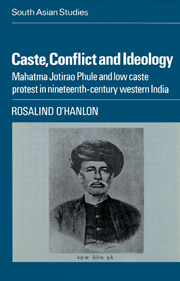 Caste, Conflict and Ideology
Caste, Conflict and Ideology from Part 4 - The creation of a lower caste identity in history and popular culture, 1869–73
Published online by Cambridge University Press: 14 October 2009
New strategies for the attack on Brahman power
Following his retirement from the managing committee of the schools for the lower castes in 1858, Phule devoted himself in the early 1860s to a variety of social reform campaigns. He took part in the first attempts in Pune to liberalise attitudes towards the remarriage of widows. In 1863 he made an even bolder move with the opening of a ‘Home for the prevention of infanticide’. Here, high caste widows who had become pregnant could come and give birth in secret and return quietly to their families, leaving the babies at the home. Posters and handbills advertised the home, which quickly collected about thirty-five infants. The survival rate amongst the children was very poor, however, and Phule's great-nephew Gajananrao reported that most of them died before the age of five. Phule and his wife Savitribai, without children of their own, adopted one of these, a boy named Yashavantrao, the son of a Brahman widow.
Phule supported these efforts by setting up in business. He had inherited a small amount of money from his father's second wife, which he invested in a metalwork shop in Pune. He became the agent for his friend Vasudev Babaji Navarange, who had been to London in 1863 to make contacts for the sale of metal-casting equipment. Phule built up a great trade selling this equipment to factories in Pune. He employed two servants at his shop, which grew to a daily turnover of about Rs 100. This business laid the foundation for the material prosperity which later enabled Phule to devote himself to the lower caste cause.
To save this book to your Kindle, first ensure [email protected] is added to your Approved Personal Document E-mail List under your Personal Document Settings on the Manage Your Content and Devices page of your Amazon account. Then enter the ‘name’ part of your Kindle email address below. Find out more about saving to your Kindle.
Note you can select to save to either the @free.kindle.com or @kindle.com variations. ‘@free.kindle.com’ emails are free but can only be saved to your device when it is connected to wi-fi. ‘@kindle.com’ emails can be delivered even when you are not connected to wi-fi, but note that service fees apply.
Find out more about the Kindle Personal Document Service.
To save content items to your account, please confirm that you agree to abide by our usage policies. If this is the first time you use this feature, you will be asked to authorise Cambridge Core to connect with your account. Find out more about saving content to Dropbox.
To save content items to your account, please confirm that you agree to abide by our usage policies. If this is the first time you use this feature, you will be asked to authorise Cambridge Core to connect with your account. Find out more about saving content to Google Drive.